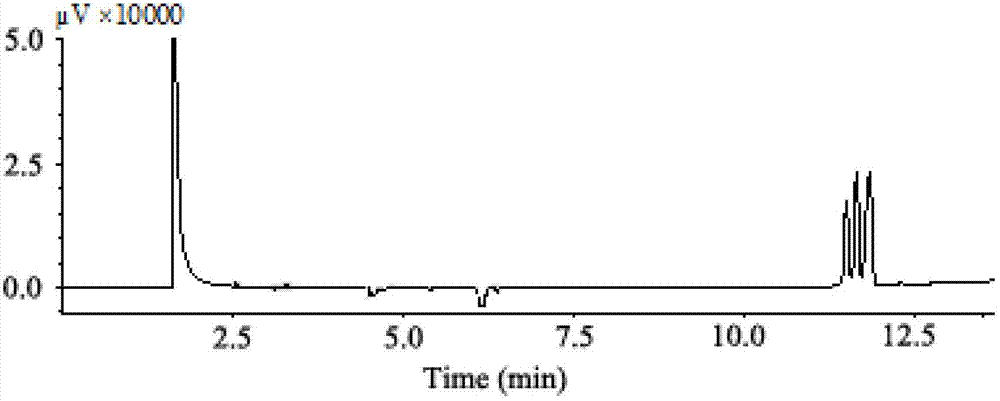Cypermethrin degrading bacteria in marine environment, and separation, purification and application thereof
A technology of cypermethrin degradation and cypermethrin, applied in chemical instruments and methods, biochemical equipment and methods, bacteria, etc., can solve environmental, food safety and human health hazards, fishery production and ecological environment impacts, etc., to eliminate biological toxicity , broad development prospects, good degradation effect
- Summary
- Abstract
- Description
- Claims
- Application Information
AI Technical Summary
Problems solved by technology
Method used
Image
Examples
specific Embodiment 1
[0022] Screening and Identification of Degrading Strains
[0023] 1. Media and reagents
[0024] Nutrient medium: Accurately weigh 0.01 g of ferric phosphate, 5.0 g of peptone, and 1.0 g of yeast extract, add 1,000 mL of filtered seawater, mix well, adjust the pH to 7.0-7.8, and sterilize with high pressure steam (121°C, 20 min) be made of.
[0025] Enriched culture medium: Add cypermethrin solution to the nutrient medium so that the concentration of cypermethrin is 100 mg / L.
[0026] 2. Isolation and purification of bacterial strains:
[0027] Seawater samples were collected from the coastal waters of Ningbo, and 500mL of seawater was taken to be filtered and enriched in a sterile state, then added to the enrichment medium containing 100 mg / L cypermethrin, and cultured at a temperature of 28°C and a rotational speed of 180 rpm. 7d, repeat the above operation process 3 times, the inoculum of each culture is taken from the culture solution obtained in the previous time, aft...
specific Embodiment 2
[0029] Identification of Beta-Cypermethrin Pesticide Degrading Strains
[0030] The bacterial strain obtained above is carried out morphological characteristics and molecular biological identification, and the electron micrograph of this bacterial strain is as follows: figure 1 shown. The main biological characteristics of the strain are: Gram negative, bacillus, β-galactosidase, arginine double hydrolysis test, citrate test, lysine decarboxylase, ornithine decarboxylation test, V-P reaction , gelatin liquefaction test positive, urease test, H 2 S reaction, tryptophan decarboxylase, indolease test negative, can not use sucrose. The strain grows in seawater, the optimum growth temperature is 25-30°C, and the optimum growth pH is 7.0-7.8. On solid medium, the colony is round, thin, white and translucent. The strain was analyzed by 16s rRNA sequence It was identified as Mesonia sp.
specific Embodiment 3
[0031] Degradation effect and application of cypermethrin-degrading bacteria on pyrethroid pesticides in seawater
[0032] Inoculate the isolated and purified strains into 100 mL of enrichment medium containing 100 mg / L cypermethrin (the preparation method is as shown in Example 1), and use the enrichment medium without inoculation as a control, at 28°C, The culture was shaken on a constant temperature shaker at 180 rpm for 7 days. After culturing, draw 2 mL of culture solution, add 0.4 g NacL, vortex and mix well, and use 4 mL of a mixed solution of n-hexane and acetone (volume ratio 1:1) and 2 mL of a mixed solution of n-hexane and acetone Extract, combine the supernatant obtained from two extractions, take 3 mL supernatant, add 0.4 g anhydrous sodium sulfate, blow dry with nitrogen, and dissolve it with a mixed solution of 1 mL isooctane and acetone (volume ratio 1:1), For GC-ECD analysis and detection, each experiment was repeated three times, and the degradation ability ...
PUM
 Login to View More
Login to View More Abstract
Description
Claims
Application Information
 Login to View More
Login to View More - R&D
- Intellectual Property
- Life Sciences
- Materials
- Tech Scout
- Unparalleled Data Quality
- Higher Quality Content
- 60% Fewer Hallucinations
Browse by: Latest US Patents, China's latest patents, Technical Efficacy Thesaurus, Application Domain, Technology Topic, Popular Technical Reports.
© 2025 PatSnap. All rights reserved.Legal|Privacy policy|Modern Slavery Act Transparency Statement|Sitemap|About US| Contact US: help@patsnap.com


